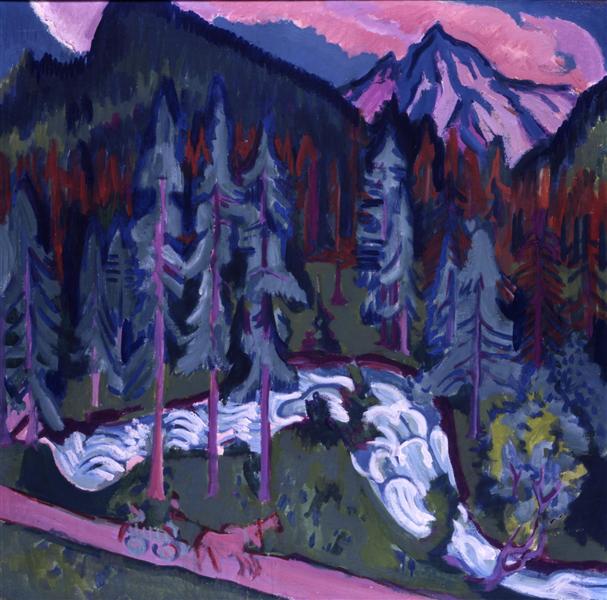Description
The work "Sertig Street" (Serigweg - 1926) by Ernst Ludwig Kirchner is presented as a fascinating exploration of the intersection between nature and human life, encapsulating a moment that transcends the everyday. Kirchner, prominent figure of expressionism, uses this painting to offer a window towards its perception of the world, where the physical and emotional are intertwined in a dance of vibrant shapes and colors.
From the first glance, the composition of "Calle Sertig" displays a mountainous landscape of remarkable beauty, where snowy peaks are majestically against a sky that exfolia bluish and off tones. This taking of natural elements combines a sense of calm and at the same time of restlessness, an effect that Kirchner managed to dominate with a mastery. The landscape of Serig, a valley in the Swiss Alps, evokes both the serenity of nature and the complexities of the human being.
The use of color is fundamental in this work, where the intense greens of the trees and roads contrast with the blue cold of the mountains and the sky. This color palette not only suggests a dialogue between climate and vegetation, but also becomes a vehicle for the expression of internal feelings. The nuances are intertwined with energy strokes, loaded with life, which allow spectators to perceive the emotional intensity that Kirchner embbe in their work.
In the painting you can see humanoid figures that, although not completely defined, serve to challenge the relationship between man and his surroundings. These forms, often interpreted as a representation of the traveler or the walker in nature, are key to understanding the experience of isolation and vastness in the mountainous stage. However, its characteristics are not detailed, which suggests that for Kirchner the fundamental is the feeling that transcends the mere figurative representation.
Kirchner's connection with the SERTIG landscape was not just aesthetics; It is relevant to remember that his life was marked by a constant displacement between large cities and the tranquility of nature. Thus, the "Serig Street" reflects its search for authenticity in a world in transformation, where urban bustle was opposed to rural calm. This contrast is emblematic of the search for expressionism, which often focuses on alienation and the need for genuine connection with the environment.
Kirchner, through his innovative style, also aligns with a tradition of visual expression that seeks to give both the landscapes and the subjects that inhabit them. The adoption of bold lines and simplified forms in "Serig Street" is a testimony of its artistic evolution, where the influences of Fauvism and post -impressionism are evident. This work, like many of its contemporaries, is located in the context of its continuous exploration of the human psyche against a changing world and, often, hostile.
In conclusion, "Serig Street" is more than a landscape: it is a visual dialogue about the relationship between the human being and its environment, an exploration of the sense of belonging and uprooting. Through its distinctive use of color and shape, Kirchner generates a space where emotional and physical converge, offering viewers a portal towards their own perception of experience lived in nature. The work remains as a powerful testimony of Kirchner's ability to express the complexity of the human soul in the context of its natural environment, an issue that resonates in the history of modern art.
KUADROS ©, a famous paint on your wall.
Hand-made oil painting reproductions, with the quality of professional artists and the distinctive seal of KUADROS ©.
Art reproduction service with satisfaction guarantee. If you are not completely satisfied with the replica of your painting, we refund your money 100%.

